

Spider-Man. Captain America. Jean Grey. In 2006, IGN rated Jean Grey #6 on their list of Top 25 X-Men from the past forty years,[1] and in 2011, IGN ranked her 13th in the Top 100 Comic Book Heroes.
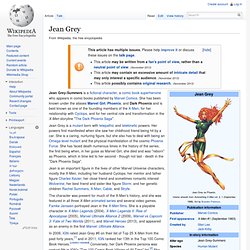
[citation needed] Conversely, her Dark Phoenix persona was ranked 9th in IGN's "Top 100 Comic Book Villains of All Time" list.[2] She was ranked third in Comics Buyer's Guide's 100 Sexiest Women in Comics list.[3] Publication history[edit] Debut (1960s)[edit] "The Phoenix Saga" and "The Dark Phoenix Saga" (1976-1980)[edit] In an attempt to save her fellow X-Men by piloting their damaged shuttle back to earth, Jean was exposed to fatal levels of radiation. This new identity and immense abilities eventually resulted in Jean becoming overwhelmed and corrupted by her god-like powers after a failed attempt by the villainous group called the Hellfire Club to control her mind. Return to publication (1986)[edit] Hawkeye. Thor. Hulk. The Hulk first appeared in The Incredible Hulk #1 (cover dated May 1962), written by writer-editor Stan Lee, penciled and co-plotted by Jack Kirby,[6] and inked by Paul Reinman.
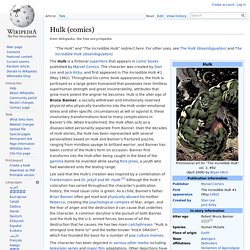
Lee cites influence from Frankenstein[7] and Dr. Jekyll and Mr. Hyde in the Hulk's creation: Lee also compared Hulk to the Golem of Jewish myth.[7] In The Science of Superheroes, Gresh and Weinberg see the Hulk as a reaction to the Cold War[9] and the threat of nuclear attack, an interpretation shared by Weinstein in Up, Up and Oy Vey.[7] This interpretation corresponds well when taken into account alongside other popularized fictional media created during this time period, which took advantage of the prevailing sense among Americans that nuclear power could produce monsters and mutants.[10] Arie Kaplan calls Hulk "schizophrenic.
Lee gave the Hulk's alter ego the alliterative name Bruce Banner because he found he had less difficulty remembering alliterative names. She-Hulk. Wolverine. Wolverine is a fictional character, a superhero that appears in American comic books published by Marvel Comics, as well as movie, television, and video game adaptations; most often in fiction related to the X-Men.

He was created in 1974 by writer Len Wein and Marvel art director John Romita, Sr. Marvel editor-in-chief Roy Thomas asked writer Len Wein to devise a character specifically named Wolverine, who is Canadian and of small stature and with a wolverine's fierce temper. John Romita, Sr. designed the first Wolverine costume, and believes he introduced the retractible claws, saying, "When I make a design, I want it to be practical and functional. I thought, 'If a man has claws like that, how does he scratch his nose or tie his shoelaces? '"[1] Wolverine first appeared in the final "teaser" panel of The Incredible Hulk #180 (cover-dated October 1974) written by Wein and penciled by Herb Trimpe. Storm. Black Widow (Natalia Romanova) Ms. Marvel.
Carol Danvers[edit] Sharon Ventura[edit] Karla Sofen[edit]
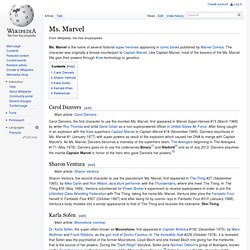
Daredevil. Elektra (comics) Bandied about the idea [of bringing back Elektra] in a casual fashion now and again, but neither of us wanted to do it as a gimmick.

On the rare occasion I thought I had a legitimate angle to use her, Ralph was cool to the idea. But as we geared up for what would become Fall From Grace, Ralph out of the blue said, "What about bringing back Elektra? " -- and it was really the missing piece that clicked together all the loose pieces of the story in my head, and became the nexus for everything tying together as well as it did.
In my mind, it's always been her to whom the title refers.[6] This upset Frank Miller, who claimed that Marvel had previously promised him that the character would not be used in any publication.[7] She has since appeared in two eponymous ongoing series and several mini-series. Elektra was born on a Greek island near the Aegean Sea to Hugo Kostas Natchios and his wife Christina Natchios. Two contradictory accounts of her family history have been given.
Iron Man. Iron Man is a fictional character, a superhero that appears in comic books published by Marvel Comics.

Ant Man. Publication history[edit] Hank Pym debuted in a seven-page solo cover story titled "The Man in the Ant Hill" (about a character who tests shrinking technology on himself) in the science fiction/fantasy anthology Tales to Astonish #27 (cover date January 1962).
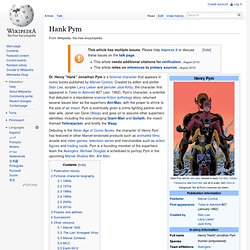
The creative team was editor-plotter Stan Lee, scripter Larry Lieber, penciler Jack Kirby, and inker Dick Ayers, with Lee stating in 2008: "I did one comic book called 'The Man in the Ant Hill' about a guy who shrunk down and there were ants or bees chasing him. That sold so well that I thought making him into a superhero might be fun".[1] Decades later, Lee theorized as to why "Ant-Man never became one of our top sellers or had his own book," saying, I loved Ant-Man, but the stories were never really successful. Pym began what would be a constant shifting of superhero identities in Tales to Astonish, becoming the 12-foot-tall Giant-Man in issue #49 (November 1963). Punisher. Deadpool. Mister Fantastic. Mister Fantastic (Reed Richards) is a fictional character, a superhero that appears in comic books published by Marvel Comics.
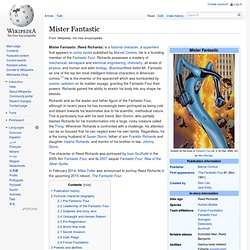
He is a founding member of the Fantastic Four. Richards possesses a mastery of mechanical, aerospace and electrical engineering, chemistry, all levels of physics, and human and alien biology. BusinessWeek listed Mr. Fantastic as one of the top ten most intelligent fictional characters in American comics.[1] He is the inventor of the spacecraft which was bombarded by cosmic radiation on its maiden voyage, granting the Fantastic Four their powers. Richards gained the ability to stretch his body into any shape he desires. Human Torch. Like the rest of the Fantastic Four, the Human Torch gained his powers on a spacecraft bombarded by cosmic rays.
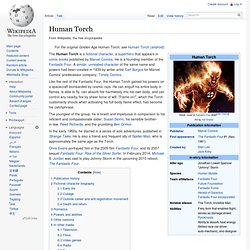
He can engulf his entire body in flames, is able to fly, can absorb fire harmlessly into his own body, and can control any nearby fire by sheer force of will. "Flame on! ", which the Torch customarily shouts when activating his full-body flame effect, has become his catchphrase. Thing. The Thing is a fictional character, a superhero that appears in comic books published by Marvel Comics.
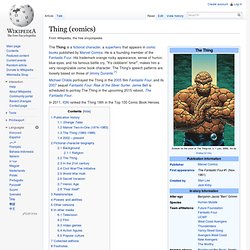
He is a founding member of the Fantastic Four. His trademark orange rocky appearance, sense of humor, blue eyes, and his famous battle cry, "It's clobberin' time! ", makes him a very recognizable comic book character. The Thing's speech patterns are loosely based on those of Jimmy Durante.[1] Invisible Woman. An object of infatuation for Doctor Doom and, most notably, Namor the Sub-Mariner, Sue's passive invisibility power translated into her frequent deployment as a damsel in distress during the team's early adventures. However, upon developing the ability to project powerful fields of energy, Sue Storm became a more powerful member of the Fantastic Four, and the team's second-in-command with a growing assertive confidence.
While Sue operated somewhat in the shadow of her brother and her husband in the early years, she is now the soul of the Fantastic Four and one of the premiere heroes in the Marvel Universe.